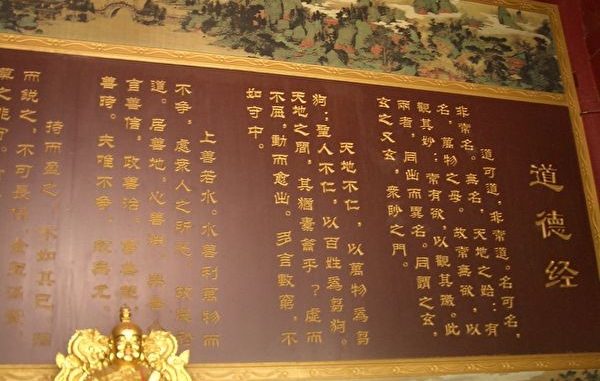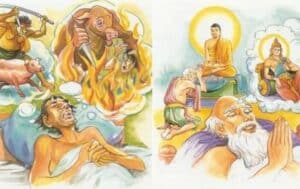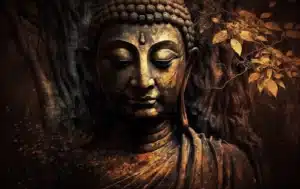Dive into the realm of Eastern philosophy, and one name you’ll encounter almost immediately is Lao Tzu. A man cloaked in mystery, this venerable sage is a pillar of Chinese thought, renowned as the founder of Taoism with a concise but intellectual text – the Tao Te Ching.
It’s like a philosophical treasure chest, revealing insights about life, the universe, and our role within it, piece by piece. Lao Tzu introduced us to the concept of ‘Tao’, the all-encompassing cosmic principle, and ‘Te’, the virtuous path of aligning oneself with the Tao. He taught us about ‘Wu-wei’, the art of ‘non-action’ or ‘effortless action’, urging us to flow with the universe’s rhythms rather than fighting against them. In this article, LotusBuddhas and you will find out who Lao Tzu is, and what his teachings are about!
Who was Lao Tzu?
Lao Tzu, also spelled as Laozi, is a seminal figure in Chinese philosophy, credited as the founder of Taoism, one of the major philosophical systems of thought that have shaped East Asian culture and history. The term ‘Lao Tzu’ itself translates to ‘Old Master’ or ‘Ancient Child’ in English, indicating the venerated status and enigmatic nature of this legendary philosopher.
Traditionally, Lao Tzu is believed to have lived in the 6th century BCE, contemporary to Confucius, though there is ongoing scholarly debate about his precise historical existence and timeline. Several traditional accounts depict Lao Tzu as a wise and older contemporary or even a mentor to Confucius, a narrative that underscores the symbolic representation of Lao Tzu as the herald of an ancient wisdom predating the more rational and humanistic doctrines of Confucianism.
However, it is important to note that most of the information we have about Lao Tzu comes from later texts and legends, which offer conflicting accounts of his life. Some scholars suggest that Lao Tzu may not have been a single historical figure, but rather a synthesis of several individuals and their ideas, conflated over time under the moniker of this iconic sage.
Arguably the most significant contribution attributed to Lao Tzu is the “Tao Te Ching“, also known as the “Daodejing” or “The Classic of the Way and Virtue.” This cryptic, poetic text forms the cornerstone of Taoist philosophy. It discusses the ‘Tao’ (the Way), an ineffable, natural principle that underlies and unifies all existence, and ‘Te’ (Virtue), the alignment of one’s actions with the Tao. The “Tao Te Ching” extols the virtues of simplicity, spontaneity, and non-contention, advocating for an understanding of the world that transcends binary distinctions and embraces paradox and change.
The ideas articulated in the “Tao Te Ching” exerted a profound influence on Chinese thought, not just in Taoism, but also in Confucianism and Chinese Buddhism, thereby shaping the cultural fabric of China. In more recent times, these ideas have also found global appeal, making Lao Tzu an enduringly influential figure in world philosophy.
What is the philosophy of Lao Tzu?
Lao Tzu’s philosophy, broadly categorized as Taoist philosophy, is predominantly encapsulated in the “Tao Te Ching,” a compendious text that highlights his philosophical insights and conceptions. The main principles of Lao Tzu’s philosophy include the concepts of Tao (The Way), Wu-wei (Non-action), and Pu (Simplicity or being natural).
Tao (The Way): Tao, the primary and most complex concept in Taoist philosophy, is an unfathomable cosmic force that pervades and guides the universe, transcending conventional dichotomies and distinctions. It is, in essence, the fundamental nature of existence, an underlying principle that cannot be entirely grasped or described with language. Lao Tzu opens the “Tao Te Ching” by stating that “The Tao that can be told is not the eternal Tao.” Nevertheless, by aligning oneself with Tao, it is possible to achieve harmony and balance.
Wu-wei (Non-action): Another critical principle in Lao Tzu’s philosophy is Wu-wei, a concept that literally translates as ‘non-action’ or ‘non-doing.’ Wu-wei does not advocate idleness or disregard for responsibility; instead, it suggests a state of spontaneous and effortless action, wherein individuals act in harmony with Tao. It encourages natural action, free from forced effort or undue intervention. By practicing Wu-wei, one aligns one’s actions with the natural flow of the universe, thereby reducing friction and achieving efficiency and harmony.
Pu (Simplicity): Pu, often translated as ‘the uncarved block’ or ‘simplicity’, refers to a state of pure potential which is untouched by societal constructs or imposed values. This concept underscores the naturalness, simplicity, and spontaneity that aligns with Tao. According to Lao Tzu, by emulating the state of Pu, one can return to the inherent nature of life, untouched by artificial influences, thereby living in alignment with Tao.
Yin and Yang: While not explicitly addressed in the “Tao Te Ching”, the philosophy of Yin and Yang is central to Taoist thought. It illustrates the interconnectedness and interdependence of opposing forces in the universe. Lao Tzu’s philosophy embraces this natural dualism and suggests harmony through balancing these opposing elements.
In essence, Lao Tzu’s philosophy offers profound insights into understanding and navigating life by aligning with the fundamental forces of the universe. The emphasis on Tao, Wu-wei, and Pu provides a unique perspective that diverges from contentiousness and artificial constructs, encouraging individuals to find peace and harmony through naturalness and spontaneity. It’s a philosophy that has not only influenced East Asian cultures but has also resonated with the rest of the world, offering universal wisdom applicable to various facets of life.
What are the main teachings of Lao Tzu?
Lao Tzu’s teachings, as detailed in the “Tao Te Ching”, offer a profound exploration of life, the universe, and the human role within it. Despite the text’s concise and often enigmatic nature, a few primary teachings can be distilled from it. These teachings have exerted a significant influence on Chinese and East Asian culture and thought.
The Tao (The Way): Lao Tzu teaches that the universe is governed by the Tao, an incomprehensible, underlying principle that transcends dualistic thinking and finite description. The Tao symbolizes the source and the driving force behind all existence. Lao Tzu encourages recognizing and aligning oneself with the Tao, thereby achieving harmony and balance in life.
Wu-wei (Non-action): Wu-wei is the practice of ‘non-doing’ or ‘non-action’. It’s not about inaction, but rather about ‘effortless action’ or ‘action without intent’. Lao Tzu advises that one should strive to act in a way that flows naturally and aligns with the Tao, rather than forcing actions based on personal desires or societal expectations.
Naturalness and Simplicity: Lao Tzu values naturalness, spontaneity and simplicity. He teaches that these qualities, embodied by the concept of Pu (the uncarved block), lead to a state of tranquillity and alignment with the Tao. Lao Tzu discourages adherence to artificial constructs or complexities, advocating for a return to a simple and authentic state of being.
Humility: Lao Tzu emphasizes humility as a virtue. He suggests that those who are humble, like a valley, can receive, whereas those who are full of themselves, like a mountaintop, can give nothing. This teaching encourages humility as a means of learning, growing, and harmoniously interacting with others.
Relativity of knowledge: Lao Tzu’s teachings underscore the relativity and limitations of human knowledge. He suggests that absolute knowledge is unattainable and that the wise are aware of their ignorance. This standpoint invites constant learning and the capacity to remain open to different perspectives and experiences.
Harmony of opposites: Embracing the natural dualism akin to the Yin-Yang principle, Lao Tzu’s philosophy respects the harmony of opposites. He teaches that seemingly opposing forces or aspects of life are interconnected and interdependent, with each containing the seed of the other. This perspective fosters acceptance and balance in the face of life’s dichotomies.
Detachment and contentment: Lao Tzu teaches the virtues of detachment from desires and contentment with what one has. This view correlates with his emphasis on simplicity and naturalness, advocating for inner peace and fulfillment rather than the pursuit of external achievements or possessions.
LotusBuddhas realized that, Lao Tzu’s teachings offer a unique philosophical perspective that encourages harmony, simplicity, humility and naturalness. They provide valuable insights into living a balanced and fulfilling life that aligns with the natural rhythms of the universe.
What are some famous quotes by Lao Tzu?
Lao Tzu has been credited with many profound and timeless aphorisms. These statements encapsulate the wisdom of Taoist philosophy and continue to be referenced in philosophical and spiritual discourses worldwide. Below are some of the most widely recognized quotes attributed to Lao Tzu:
- On the Tao: “The Tao that can be spoken is not the eternal Tao.”This quote reflects the ineffable nature of the Tao, the essential cosmic principle according to Taoist philosophy. It suggests that the true Tao transcends linguistic articulation and conceptual grasp.
- On Wu-wei: “Do nothing and everything will be done.”This aphorism encapsulates the Taoist concept of Wu-wei, or non-action, suggesting that one can accomplish more by aligning oneself with the natural flow of the universe rather than resorting to forceful or contrived action.
- On Knowing Others and Self: “He who knows others is wise; he who knows himself is enlightened.”This quote highlights the primacy of self-knowledge, suggesting that true wisdom and enlightenment lie in introspective understanding and self-awareness.
- On Simplicity: “In pursuit of knowledge, every day something is added. In the practice of the Tao, every day something is dropped.”This quote contrasts the acquisition of external knowledge with the Taoist principle of simplicity and non-doing, suggesting that the path to Tao involves shedding complexities and unneeded desires.
- On Strength and Softness: “The soft overcomes the hard. The gentle overcomes the rigid. Everyone knows this is true, but few can put it into practice.”This aphorism mirrors the Taoist appreciation of the complementary interplay of opposites, akin to the yin-yang principle. It conveys the idea that flexibility and adaptability, considered ‘soft’ qualities, can overcome ‘hard’ forces of resistance and rigidity.
- On Contentment: “Be Content with what you have; rejoice in the way things are. When you realize there is nothing lacking, the whole world belongs to you.”This quote reflects Lao Tzu’s philosophy of contentment and gratitude. It underscores the idea of finding happiness and fulfillment not in external possessions or achievements, but in recognizing and appreciating the inherent completeness of one’s present state.
You have to note that these quotes have been translated and interpreted in various ways over the centuries, the essence of Lao Tzu’s philosophical insights, as encapsulated in these aphorisms, remains consistent, offering timeless wisdom on life, the self and the universe.
What is the Tao Te Ching?
As LotusBuddhas briefly shared above, the “Tao Te Ching”, also known as “Daodejing”, is a central text in Chinese philosophy, primarily associated with Taoism. Traditionally attributed to the sage Lao Tzu, its name can be translated into English as “The Classic of the Way and Virtue”, and it is one of the most translated works in world literature.
The “Tao Te Ching” is a relatively brief text, typically composed of 81 short chapters or sections, though the number and arrangement of these sections can vary in different translations and editions. The text is cryptic and poetic, characterized by its concise, aphoristic style and its frequent use of paradox, analogy and antithesis. Despite its brevity, the “Tao Te Ching” covers a wide array of philosophical and practical topics, offering profound insights into the nature of existence, human conduct and governance.
The “Tao Te Ching” is grounded in two fundamental concepts: Tao and Te. Tao, often translated as ‘The Way’, is a complex and central concept in Taoism. It represents an ineffable, transcendent principle that underlies and guides the universe, defying precise definition or conceptual grasp. Te, usually translated as ‘virtue’, represents the alignment or conformity of one’s behavior with the Tao. By living according to the Tao, one can embody Te, leading to a life of harmony, balance and effortless effectiveness.
Another important theme in the “Tao Te Ching” is Wu-wei, a concept that literally translates to ‘non-action’ or ‘non-doing’. Wu-wei does not suggest idleness or passivity but rather emphasizes action that is in accord with the natural flow of the Tao. This principle advocates for spontaneity, naturalness, and effortlessness in one’s actions and decisions.
In addition to its philosophical teachings, the “Tao Te Ching” also includes pragmatic advice on leadership and governance, advocating for rulers to govern with humility, simplicity, and non-interference, enabling their subjects to live in accordance with the Tao.
Scholarly debate surrounds the origins, authorship, and dating of the “Tao Te Ching”. Traditionally, it is attributed to Lao Tzu, a figure believed to have lived in the 6th century BCE, but some modern scholars propose that the text may be a compilation of wisdom from multiple authors, compiled over a longer period.
Regardless of these debates, the “Tao Te Ching” is an undeniably influential text, profoundly impacting Chinese philosophy, culture, and spirituality. Its teachings have resonated far beyond their cultural origin, contributing significantly to global philosophical and spiritual discourse.










